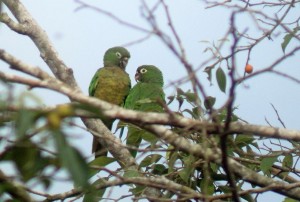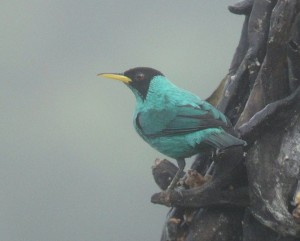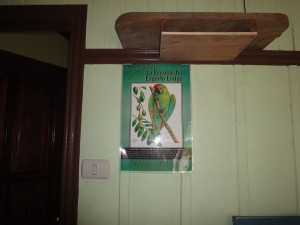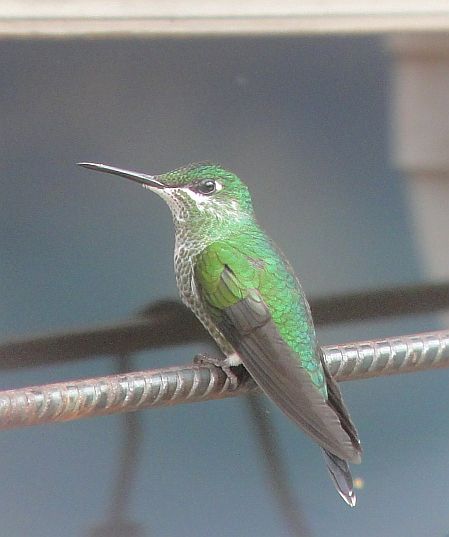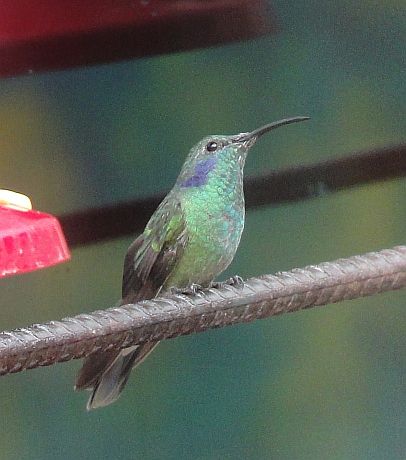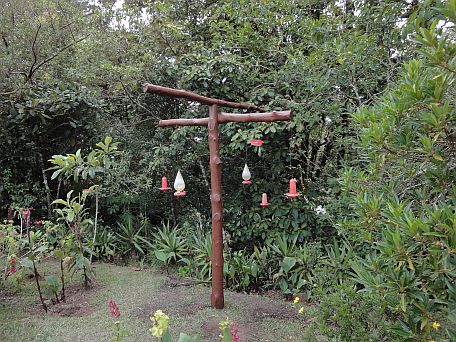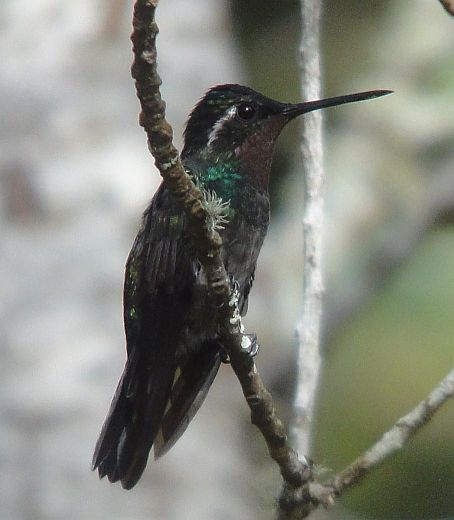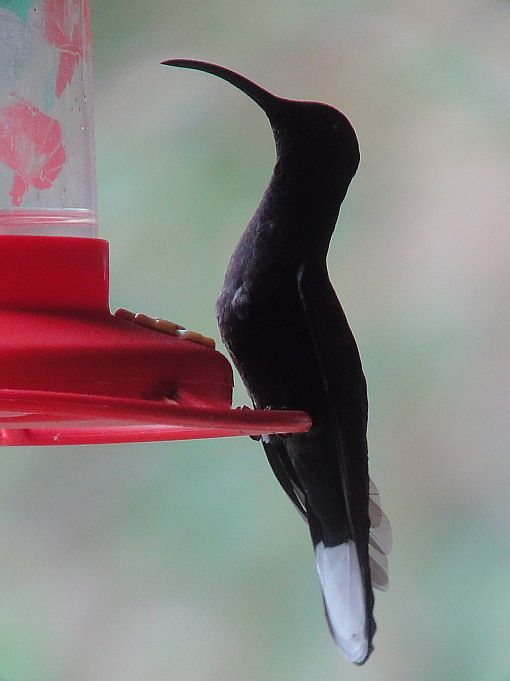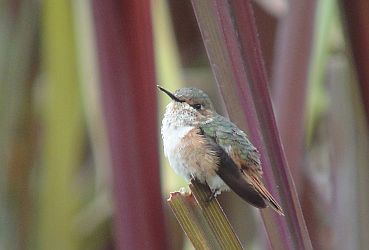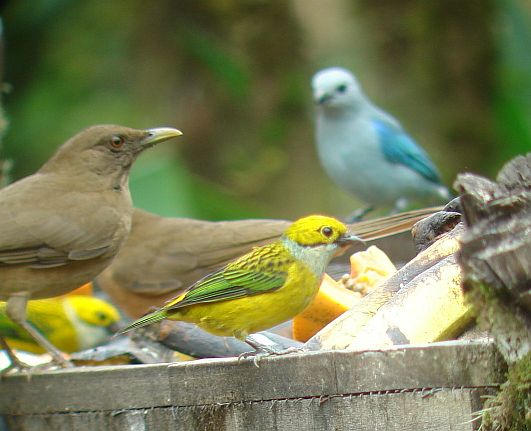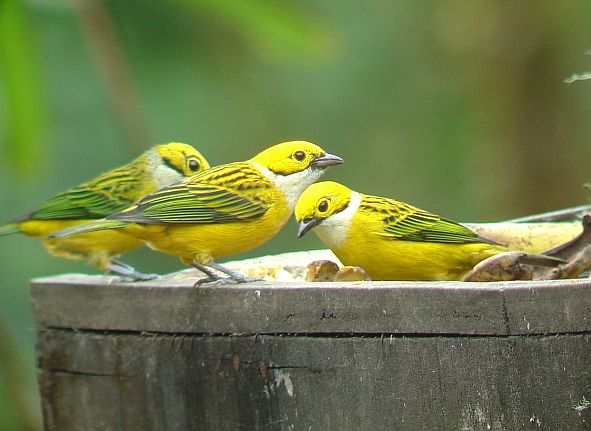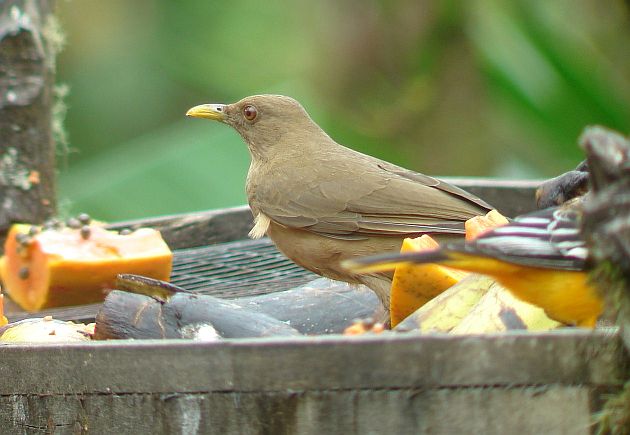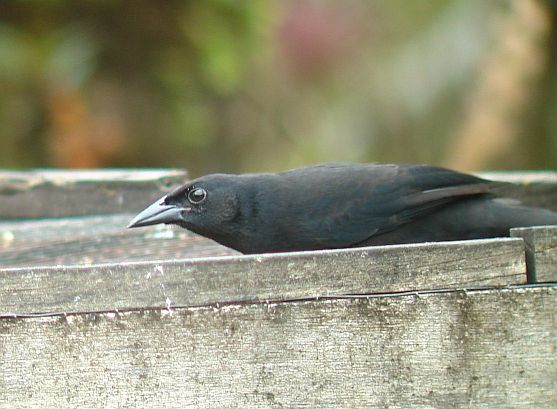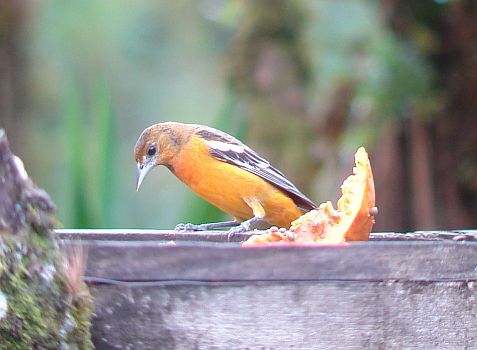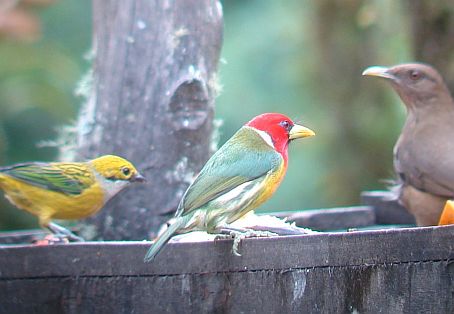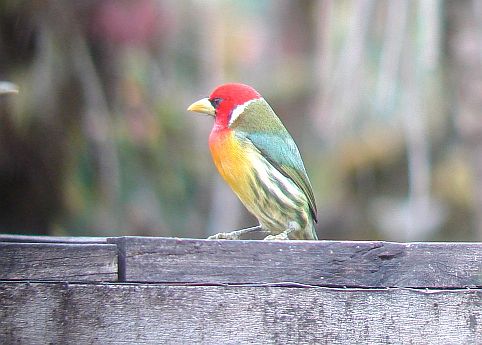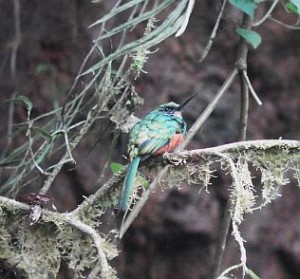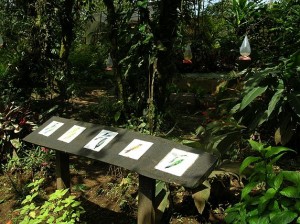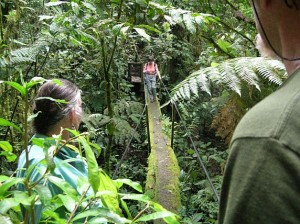This past weekend I visited Rara Avis, one of the classic birding sites for Costa Rica.

Lattice-tailed Trogon- a fairly common bird at Rara Avis.

There were several Olive-sided Flycatchers in the area. Love these birds!
Founded in 1983 by conservationists, Rara Avis started out as an organization whose goal was to demonstrate that rain forest could be managed in both a profitable and wise manner. Or, in other words, that people will benefit far more from keeping the spectacular rain forests of Costa Rica intact as opposed to cutting them down. With this concept playing a central role in all things Rara Avis, it’s no wonder that they became pioneers of ecotourism in the rainforest. On my recent visit to Rara Avis, I discovered that more than 20 years later, they have stuck to this central theme, and in my opinion, the place still ranks among the top birding sites in Costa Rica.

Area around lodge.

Rara Avis at dawn.
Ironically, it doesn’t attract very many birders. Only a fortunate few include Rara Avis on trips that visit other “must see” sites such as Monteverde, Carara, la Selva, and the Dota region. Those few birders that make it to Rara Avis, though, are indeed fortunate because they end up seeing a variety of species difficult to find elsewhere in the country. The 360 plus species list at Rara Avis includes such birds as Great, Slaty-breasted, and Little Tinamous, Great Curassow, Crested Guan, Wood-Quails, Sunbittern, Barred Hawk, Ornate Hawk-Eagle, Tiny Hawk, Purplish-backed Quail-Dove, Great Green Macaw, Vermiculated Screech-Owl, Central American Pygmy-Owl, White-chinned Swift, Green-fronted Lancebill, Violet-headed Hummingbird, Lattice-tailed Trogon, Lanceolated Monklet, Barbets, Yellow-eared Toucanet, Brown-billed Scythebill, Immaculate Antbird, Spectacled, Thicket, and Black-crowned Antpittas, Black-headed Antthrush, Thrushlike Schiffornis, Speckled Mourner, Bare-necked Umbrellabird, Nightingale Wren, Pale-vented Thrush, many tanagers including Blue and Gold, Black and Yellow, and Ashy-throated Bush, and Scarlet-thighed Dacnis.
All of these are regularly heard or seen at Rara Avis. Indeed this may be the most reliable spot in Costa Rica for Blue and Gold and Ashy-throated Bush-Tanagers. One of the guides who became a birder at Rara Avis told me that he had been pretty surprised when he found out that Blue and Gold Tanager was NOT one of the most common species in Costa Rica because at Rara Avis he was seeing several every single day.
Incredible as that sounds, it should actually be expected to see a few “rare” bird species at Rara Avis. The reason for this is because most of these “rare” birds require the type of extensive, primary rainforest at Rara Avis that has become very difficult to gain access to on the Caribbean slope. In addition to the above mentioned species, there are a few other indicators that Rara Avis harbors some very special habitat. It was one of the last places where Red-throated Caracaras have been seen in Costa Rica (the other sites are on the Osa Peninsula), is one of the few sites where Crested Eagle has been seen in Costa Rica (the other sites being the Osa Peninsula, Pocosol, and Tortuguero), and is one of the only sites where Wing-banded Antbird has been possibly seen in Costa Rica. The antbird in particular is a most intriguing and enigmatic record. A ground loving antbird that occurs in lowland rain forest in Nicaragua, Panama, and northern South America, this peculiar species is considered hypothetical for Costa Rica. Nevertheless, in speaking with Wilbur, the resident bird guide at Rara Avis, it’s hard to believe that he saw anything but Wing-banded Antbird. He got very good looks at the bird on three occasions during 2001, but hasn’t seen it since. He even showed me the exact spot along the “Plastico” trail where he saw the bird, an area that at that time was mostly closed canopy primary forest of about 650 meters elevation.

The hummingbird feeders attract…

Green-crowned Brilliants,



lots of Violet-crowned Woodnymphs,

and lots of Orangish Nectar feeding bats at night!
Considering that Rara Avis has so much to offer for birders, their relative absence is almost as enigmatic as Wilbur’s sighting of Wing-banded Antbird. Although the accommodation at Rara Avis is more basic than that of other lodges, it is clean and several rooms have balconies that provide views into the canopy. A stay at the lodge that includes meals, guided walks, and transportation from Las Horquetas is also priced accordingly (about $80-$90 per person). The only real issue and barrier for most people is the road that leads to Rara Avis. It can’t be driven and although it qualifies as a road for maybe one third of its length, better terminology for the rest of the way might be “rough track”, “extremely rough passage”, or “blasted, lurching, boulder-strewn mudway”. I think this last description best portrays the access road to Rara Avis. The 15 kilometer trip takes around 3 hours and involves an Ok ride on a durable truck and a pretty awful ride on some sort of cart pulled by a tractor. The cart thing on its own is actually comfortable with well-padded seats. It’s the huge rocks and ruts found along the way that are the problem. They make the cart jump and jerk like a rusty, maniacal ride operated by a bipolar carnie who neglected to take his meds. Actually, lots of people endure the ride up and kids would probably enjoy it. For people who aren’t as pliable or resistant though, that ride up and down is another matter entirely. For birders visiting Costa Rica who can handle the “road”, 3-4 nights at Rara Avis will probably turn up some of the best birding of their trip. On a bright note for birders who can’t handle the rough ride (I barely can), there has been talk of actually fixing it. Although some worry that this might take away from the experience, about the only thing that it will change at Rara Avis is putting this excellent site back on the itinerary of every birder visiting Costa Rica.

The Unimog truck.

The tractor cart thing.

The infamous “road”.

Rara Avis is also very good for herps and has the highest recorded herp diversity for Costa Rica. This Eyelash Viper was poised to strike at this heliconia. While I took a pics, a Long-billed Hermit was feeding nearby. It fed on all the heliconias in that area except for this one!
On my short visit (one night and morning of birding), here is a list of all things identified from the cattle pastures of Las Horquetas up to the beautiful forests of Rara Avis. Birding was more or less limited to the clearing at the Waterfall Lodge, and along the El Plastico trail. A huge number of trees along most of the El Plastico trail were unfortunately felled by an odd, violent windstorm a few years ago. Although this has affected the quality of the habitat along this trail, other trails at Rara Avis still provide access to beautiful primary forest. During my stay, the hot and sunny weather quieted things down quite a bit. Nevertheless, I identified 111 species in just one brief evening and morning of birding and am sure I would have gotten several more if I had stayed for two more nights. My best birds were Bare-necked Umbrellabird, and Cerulean Warbler!
Black-breasted Wood-Quail- h
King Vulture- a few seen
Barred Hawk- 2 heard
Black Vulture- a few seen
Turkey Vulture- a few seen
Gray Hawk- few seen along road.
Bat Falcon- seen and heard
Barred Forest Falcon- 1 heard
White-throated Crake- heard El Plastico clearing.
Gray-breasted Crake- one called from marshy pasture along road when tractor stopped for 3 minutes.
Gray-necked Wood-Rail- pair foraging in garden.
Purple Gallinule- marshy pasture.
Northern Jacana- marshy pasture.
Red-billed Pigeon- 2 along road.
Pale-vented Pigeon- near Las Horquetas along road.
Short-billed Pigeon- a few heard.
Ruddy Ground Dove- a few along road.
Purplish-backed Quail-Dove- one singing in morning from perch 3 meters high inside forest near kitchen.
Crimson-fronted Parakeet- a few along road.
Olive-throated Parakeet- one pair along road.
Orange-chinned Parakeet- a few along road.
Red-lored Parrot- a few along road.
White-crowned Parrot- a few along road.
Groove-billed Ani- a few along road.
Mottled Owl- 1 heard at night.
Central American Pygmy Owl- 1 heard 6:00 P.M.
White-collared Swift- a few flocks.
Green Hermit- a few in forest.
Stripe-throated (Little) Hermit- several.
Long-billed Hermit- a few in forest.
Violet Sabrewing- 2 in forest.
Green-crowned Brilliant- a few at feeders.
Violet-crowned Woodnymph- most common hummingbird. Several at feeders and many in forest.
Rufous-tailed Hummingbird- 1 second growth.
Violet-headed Hummingbird- several at Verbania around lodge.
Black-throated Trogon- a few heard, 1 seen forest.
Lattice-tailed Trogon- a few heard, 1 seen forest.
Chestnut-mandibled Toucan- few heard and seen.
Keel-billed Toucan- 1 seen El Plastico.
Collared Aracari- a few seen El Plastico.
Black-cheeked Woodpecker- several heard and seen.
Smoky-brown Woodpecker- 1 seen.
Spotted Barbtail- 1 heard.
Buff-throated Foliage-gleaner- 1 heard, 1 seen.
Wedge-billed Woodcreeper- a few heard and seen.
Spotted Woodcreeper- a few heard and seen.
Fasciated Antshrike- 1 heard.
Russet Antshrike- a few El Plastico.
Immaculate Antbird- 1 heard around lodge.
Thicket Antpitta- a few heard along El Plastico trail. Their population should be booming with all the gaps created by the storm.
Black-faced Antthrush- a few heard and seen.
Paltry Tyrannulet- very few heard and seen.
Common Tody Flycatcher- heard and seen Las Horquetas.
Scale-crested Pygmy Tyrant- several heard and seen.
Ochre-bellied Flycatcher- a few seen.
Olive-sided Flycatcher- at least 7 different birds seen! Must be coming through in numbers.
Eastern Wood-Peewee- 1 heard.
Tropical Peewee- 1 El Plastico.
Black Phoebe- along road.
Dusky-capped Flycatcher- El Plastico.
Boat-billed Flycatcher- 1 heard.
Social Flycatcher- along road.
TK- along road.
Eastern Kingbird- small flock along road.
Bare-necked Umbrellabird- pair seen near El Plastico. Female sallied out to snatch a large katydid- incredible!
White-collared Manakin- 1 lodge clearing.
Red-eyed Vireo- a few seen.
Lesser Greenlet- a few seen and heard.
Blu and white Swallow- a few seen.
Barn Swallow- constantly migrating overhead.
Bank Swallow- several migrating overhead.
Purple Martin- group of dozen of both sexes along road.
Long-billed Gnatwren- a few heard.
Tawny-faced Gnatwren- 1 heard.
Stripe-breasted Wren- several heard, a few seen.
White-breasted Wood-Wren- a few heard.
Nightingale Wren- a few heard.
Pale-vented Thrush- several seen.
Clay-colored Robin- heard Las Horquetas.
Blackburnian Warbler- a few seen.
American Redstart- several seen.
Canada Warbler- 1 seen.
Cerulean Warbler- at least 2 seen very actively foraging high up with mixed flock near El Plastico.
Buff-rumped Warbler- 1 heard river at lodge.
Gray-crowned Yellowthroat- a few heard road.
Bananaquit- a few heard and seen.
Ashy-throated Bush-tanager- several in mixed flock near El Plastico.
Olive Tanager- a few heard and seen.
White-shouldered Tanager- pair seen.
Tawny-crested Tanager- a few heard.
Black and yellow Tanager- several seen and heard.
Passerini’s Tanager- several at El Plastico.
Speckled Tanager- a few near lodge.
Golden-hooded Tanager- along road.
Silver-throated Tanager- 1 seen.
Blue-gray Tanager- a few along road.
Palm Tanager- a few along road.
Scarlet-thighed Dacnis- a few around lodge.
Green Honeycreeper- a few.
Shining Honeycreeper- a few.
Variable Seedeater- several along road.
Orange-billed Sparrow- a few near lodge.
Buff-throated Saltator- a few in gaps.
Black-faced Grosbeak- several in forest.
Eastern Meadowlark- a few along road.
Scarlet-rumped Cacique- a few heard in forest.
Montezuma Oropendola- a few along road.
Olive-backed Euphonia- several heard and seen.
Tawny-capped Euphonia- several heard and seen.















